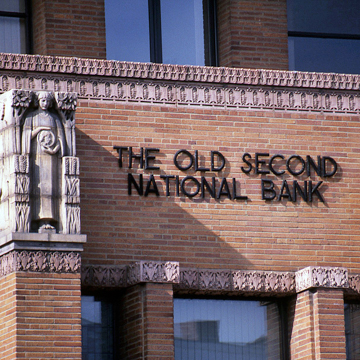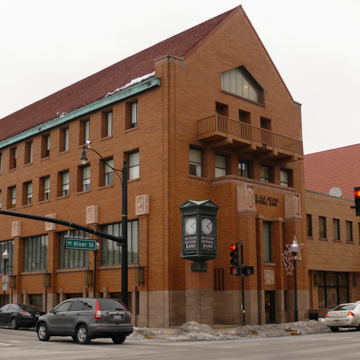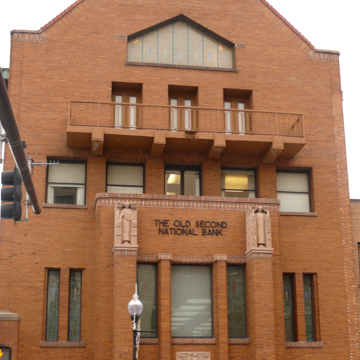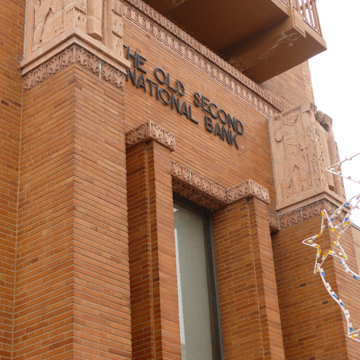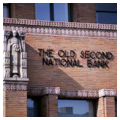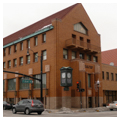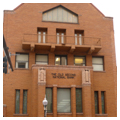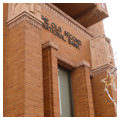For nearly a century, this four-and-a-half-story, brick and terra-cotta building has anchored the west side of downtown Aurora, serving continuously as a community bank. It is a unique example of a vertically oriented commercial design by an architect known for his work in the Prairie Style.
When leaders of Old Second National Bank sought to expand in downtown Aurora, a river town thirty miles west of Chicago, its officers turned to architect George Grant Elmslie, who had worked with Louis Sullivan for more than a decade, on such projects as the Wainwright Building (1891) in St. Louis, the Schlesinger and Meyer Department Store (1899-1903) in Chicago, and the National Farmer’s Bank (1908) in Owatonna, Minnesota.
Old Second is one of five buildings Elmslie designed in downtown Aurora shortly after starting a solo practice in 1922. Unlike the other four, the form of this building is strongly vertical, suggesting an oversized gable-roofed residence set on a narrow urban lot. In that respect, it is remarkably similar to two other Elmslie designs: the Kasson Municipal Building (1917) in Minnesota and the Capitol Building and Loan in Topeka, Kansas (1924; demolished 1961).
Old Second is set on a six-foot-high base of pink granite, above which are golden brown, narrow Roman-style bricks, laid with horizontal-raked mortar joints. The bank’s main entrance is located along the building’s narrow end facing River Street and is flanked by masonry piers topped with terra-cotta blocks. The bas relief ornament on these blocks, depicting symbols of civic and agrarian growth, was designed by Emil R. Zettler and sculpted by Kristin Schneider. Above the entrance are a decorative secondary cornice, a balcony, and a triangular-shaped window.
A series of ten, one-and-a-half-story pilasters lines the building’s long side elevation facing Downer Place. Between the pilasters are stained glass windows with a stylized geometric motif and above them are punched window openings. A dormer punctuates the side gable roof; it is similar in scale, but much larger than those typically found in residential designs of the period.
The entrance lobby leads to a two-story banking hall that has been altered over time, although John Warner Norton’s three-panel mural of the city’s early history continues to grace the north wall. The building was designed to be multipurpose and included a 200-seat auditorium (basement), third-floor office space, and a private club on the fourth and fifth floors.
The Aurora bank was restored in 1980 by the local firm of Cordogan, Clark and Associates, which also designed a 30,000-square-foot office addition in a complementary style to the north. The entire complex continues to operate as a community bank.
References
Gebhard, David, Purcell & Elmslie: Prairie Progressive Architects. Salt Lake City: Gibbs Smith, 2006.
George Grant Elmslie: Special Interest Architectural Tour. Aurora: Historic Preservation Commission, 2010.
Koeper, Frederick. Illinois Architecture from Territorial Times to the Present.Chicago: University of Chicago Press, 1968.








